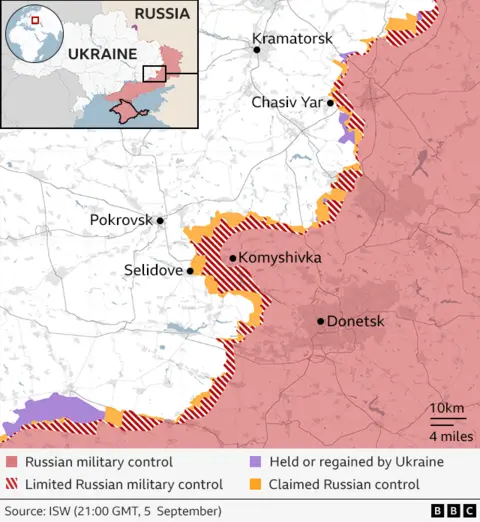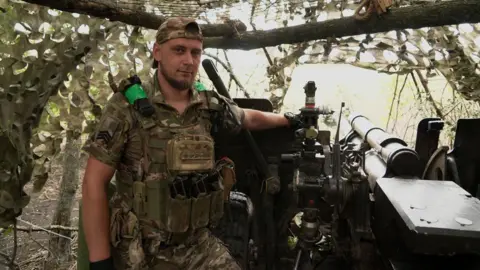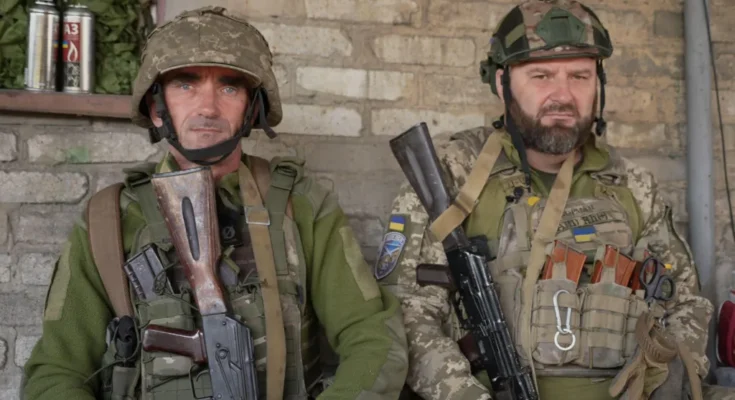Fleeing the town she has lived in most of her life, Maria Honcharenko is taking just one small bag, and her two tiny kittens.
After stubbornly staying on in the east Ukrainian city of Pokrovsk, the 69-year-old is now heeding advice and preparing to leave.
“My heart stops when I hear a bang,” she tells me, crying. She’s holding an old push-button phone where emergency contacts are saved.
The front line is less than 8km (4.9 miles) from Pokrovsk. Serhiy Dobryak, the head of the city’s military administration, says that Russians target the city not just with ballistic missiles and multiple rocket launchers – they also now strike with guided bombs and even artillery, as the city is now within the range of those weapons too.
“Look what Russians did to us. I worked here for 30 years and now I am leaving everything behind,” she says, breaking down in tears.
Volunteers help Ms Honcharenko to get on an evacuation bus. Trains no longer run here.

Pokrovsk is a key transportation hub. If it falls, then Russian forces will cut off one of the main supply routes in the region. This will likely force Ukraine to retreat from Chasiv Yar and the front line will move closer to Kramatorsk.
For Ukraine, this would effectively mean the loss of almost the entire Donetsk region, which the Kremlin has fought to capture since the beginning of their invasion.
The Ukrainian military admits that its incursion into Russia’s Kursk region failed to force Moscow to divert its troops from eastern Ukraine.
And some observers argue that this move, which certainly helped to boost morale among the soldiers, left the strategic supply route vulnerable to Russian attacks.
On Sunday, Russia claimed to have taken control of the village of Novohrodivka, just 10km from Pokrovsk. Kyiv has not commented but sources told the BBC that Ukrainian forces have retreated from there.
The space on the evacuation bus quickly fills up. A woman with a five-year old daughter climbs on board.
This is their second evacuation. The first time it was in 2022 when they fled from a border town after Russia launched its full-scale invasion of Ukraine.
This city is clearly Moscow’s top priority. According to Serhiy Dobryak, the head of Pokrovsk’s military administration, the ratio of forces fighting in that direction is 10 to one in Russia’s favour.

During its latest attack, Russia hit a substation in Pokrovsk, leaving half the city without power. The strikes also disrupted water supplies.
The city is quickly becoming deserted. Just two months ago, 48,000 people were still living here. Today half of them have already left.
The bustling downtown with shops and supermarkets is eerily quiet. Banks, supermarkets and most cafes are closed. The hospital has been evacuated.
Outside the city, excavators are digging new trenches in the fields.
However, Oleksandr Syrskyi, Ukraine’s commander-in-chief says that the army has managed to stop the Russian advancement towards Pokrovsk.
Lt Col Oleh Demyanenko, a battalion commander of the 110th brigade, told the BBC that the front line on the northern flank of Russia’s assault on Pokrovsk had indeed been stabilised. However, Russian attacks are mostly focused on the southern flank, he says, where heavy battles are continuing.
One of the areas on that flank that Russians are trying to seize is Selidove, a small town south-east of Pokrovsk.
The BBC visited an artillery position of the 15th Brigade of the National Guard that defend this town. Relentless Russian attacks give them no respite.
“Prepare for action!” the unit commander Dmytro orders after receiving coordinates of a new target.
All crew members rush to an old American M-101 howitzer. This type of gun was used in World War Two. Now Ukrainians fire it to stop Russian attacks.

The commander shouts “Fire!” and pulls the rope. The explosion is deafening. The gun is covered with smoke.
The fighting in his sector is very intense, says 31-year-old Dmytro.
“The enemy attacks in groups of up to 15 people, sometimes up to 60,” he said. “We fire up to 200 rounds a day [to repel them].”
This is a big change to last winter when big guns stayed silent for most of the day.
But the more they shell the Russian positions, the greater the risk of return fire. So, after each series of rounds, they head to a dugout to wait out Russia’s counter barrage.
And when they hear a loud thud in the distance, they go quiet. “A glide bomb,” one of the soldiers mutters. It’s this weapon that they fear the most. It has a devastating effect and the gunners have nowhere to hide from it.
Dmytro gives an evasive answer when asked whether it would be more useful to use Ukrainian forces involved in the Kursk operation to defend the Donbas region instead. “Commanders have a better view to make strategic decisions,” he said.
The front line here can move quickly. Sometimes it can be a total surprise for Ukrainian forces.
Last month, a group of seven soldiers of the 68th Brigade started their shift at the forward position in the village of Komyshivka, 15km west of Selidove. Their task was to stop any attempts of Russian forces to break through. The next day, however, they were encircled by the Russian forces.
Thanks to extremely brave drivers and the negligence of Russian soldiers, they were evacuated three days later.
Back in Pokrovsk, the evacuation bus with Ms Honcharenko on board is full. They have to take a new route as the bridge on the way out of town is damaged by the Russian strikes. As the bus starts moving, people wave through the windows and wipe their tears away.
For Maria Honcharenko, this is a scary journey full of uncertainties. But she knows one thing – it will be safer in her new home than remaining at the front line.

